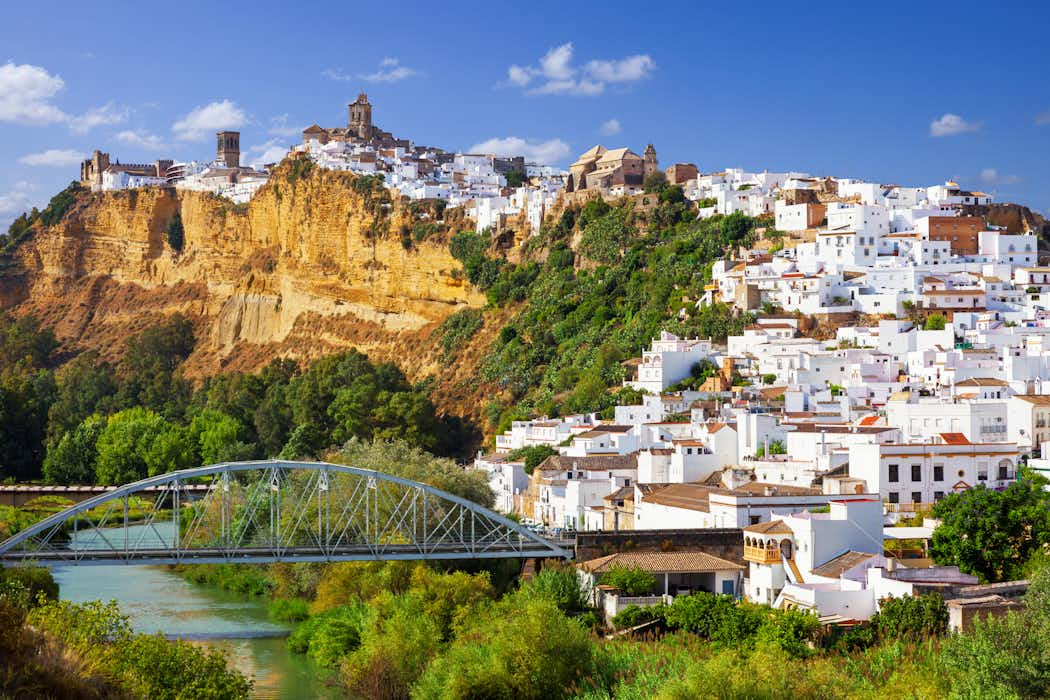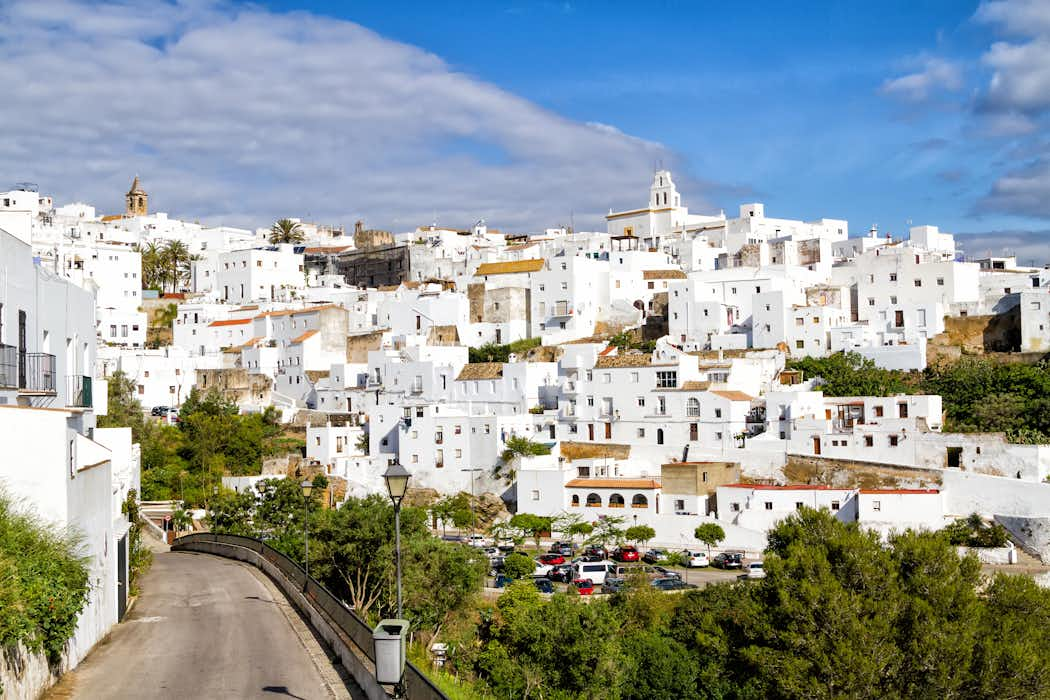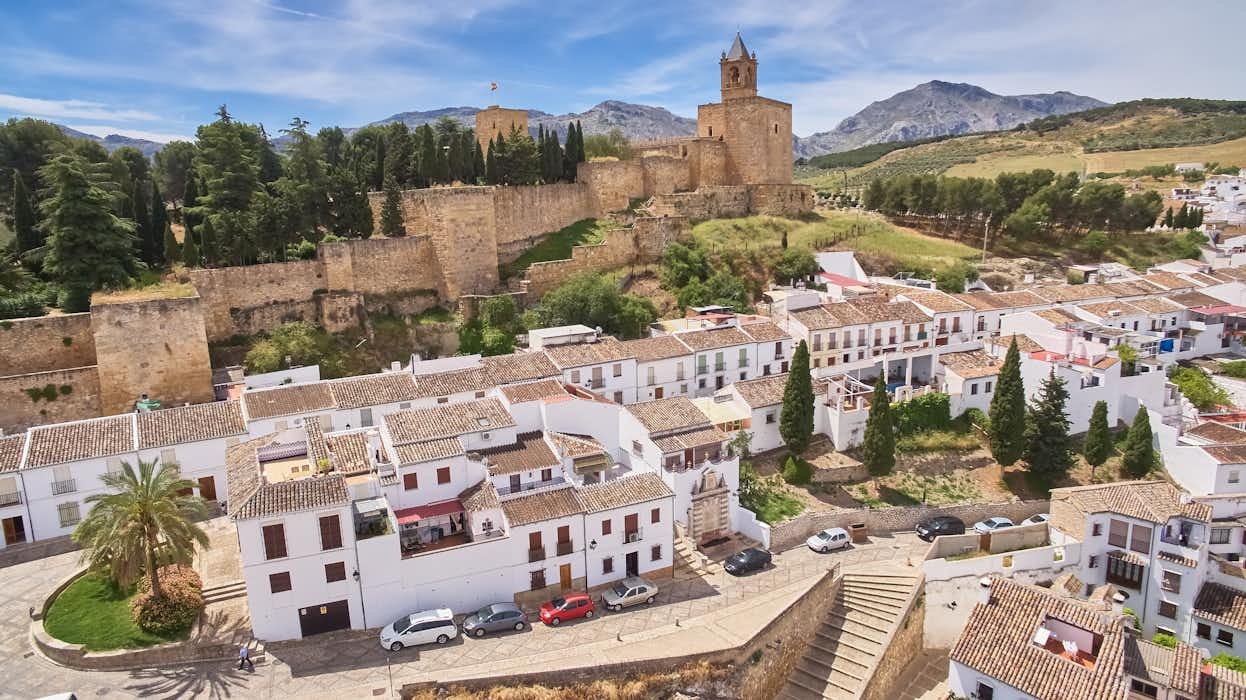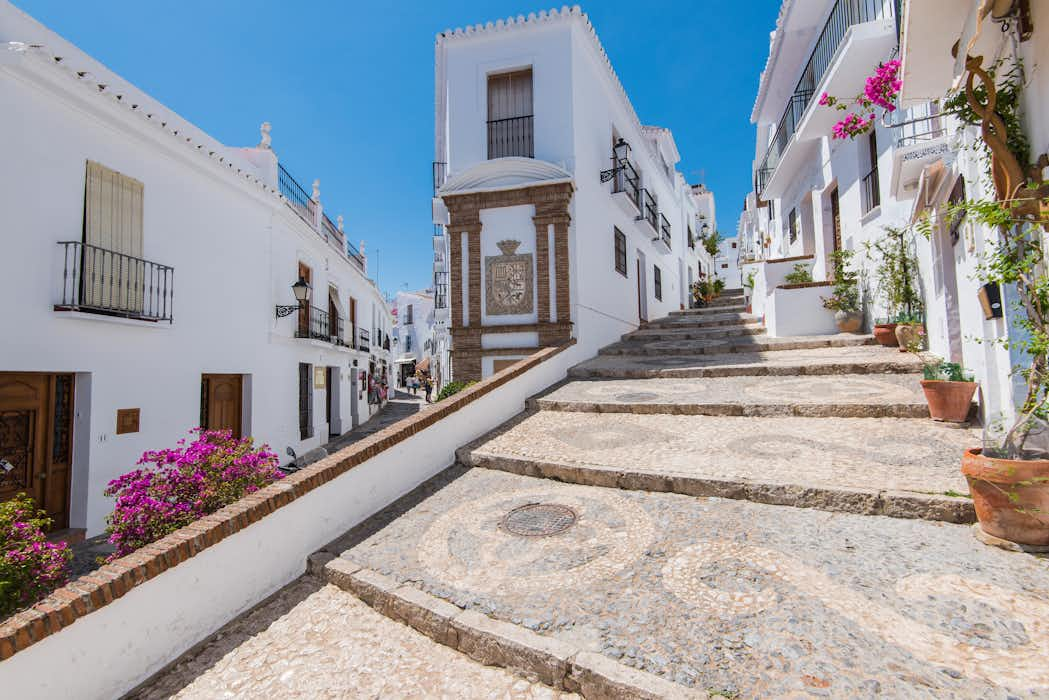White Villages of Andalusia Tour
Andalusia’s White Villages, or "Pueblos Blancos", are some of Spain’s most famous attractions. Characterized whitewashed walls and red-tiled roofs, the villages are both beautiful and historic, with some dating back to the Roman and Moorish eras. Many of these villages are made even more dramatic by their natural surroundings, be it Spanish Fir and Maple forests or rugged cliffs! With Daytrip, you can experience the beautiful Spanish countryside, and the spice of Southern Spain in its entirety with this thematic tour. From the plazas of Seville, to the beaches of Marbella, to the historical Islamic and present Catholic grandeur of Cordoba, you will not find a dull moment on this tour!
Andalusia White Village Tour Itinerary
Seville to Cadiz (stop in Arcos de la Frontera, Medina-Sidonia)
Cadiz to Marbella (stop in Vejer de la Frontera, Ronda)
Marbella to Granada (stop in Mijas, Antequera)
Granada to Cordoba (stop in Frigliana, Montefrio)
Day 1: Seville to Cadiz
https://www.youtube.com/watch?v=kb08lxcVXOsFrom a Phoenecian outpost, Seville grew into one of the great market and trading centers of Roman Hispania. You'll find a great array of archaeological remains scattered throughout the 2,200-year-old city, like the Canos de Carmona, a portion of the old Roman aqueduct. Go to Marmoles Street to find three pillars of a temple, as the defensive walls built during the rule of Julius Caesar. After being captured by the Moors, Seville was the capital of the Umayyad Caliphate from the 8th to 13th Centuries. This Moorish influence has come to define the city, from the lavish Alcazar to the bell tower of the UNESCO-listed Seville Cathedral. Today, you will find the city to be a beautiful mix of Roman, Moorish and Castilian architecture and sights. There is also an array of modern monuments, such as the Metropol Parasol, the largest timber-framed structure in the world! After you've had your fill of Seville's sights, begin your tour of the White Villages of Andalusia by heading to Cadiz.
Arcos de la Frontera

Stop for two hours in Arcos de la Frontera to take in the beauty of one of Spain's most dramatic White Villages. The jumble of white houses follow a sheer cliff up to an 11th century Moorish castle. While the castle is off limits to the public, the Calle Nueva was the castle moat until the 1755 Lisbon earthquake collapsed a stretch of wall. Don't miss the 17th century Convento de las Mercedarias Descalzas, the only remaining cloistered convent in Arcos. If you have a sweet tooth, its nuns make and sell homemade sweets.
Medina-Sidonia
https://www.instagram.com/p/B_hE5-MKdfz/Founded by the Phoenicians, some historians consider Medina-Sidonia the oldest city in Western Europe. Despite its rich history, it's relatively unknown to travelers, so you can experience authentic Andalusia during your 60-minute visit. Walk across the Roman bridge before heading to the Santos Mártires Hermitage, where you'll find the oldest Visigoth art in Andalusia. You'll also find Moorish monuments, like the 12th century Torrestrella Castle, and a striking combination of Gothic and Plateresque at the Santa María la Mayor Coronada Church. While walking, be sure to try the famous "Alfajor de Medina", a Moorish pastry made with honey and typical Arab spices.
Arrival in Cadiz
https://www.youtube.com/watch?v=vxpHUwp20wAOfficially the oldest continuously inhabited city in Western Europe, Cadiz is dripping with sun, history, and culture. Founded by the Phoenicians, you can amazingly still see remnants of their settlement at the Gadir Archaeological Site! The Old Town is a jumble of narrow streets lined with buildings in a slew of architectural styles, which give way to large plazas. The verdant Plaza de Mina is perhaps the finest in the city. Built in the 19th century on top of former orchard of the convent of San Francisco, it's perfect place to relax in the shade. It's also a great place to learn about the city's 3000-year history - the Museum of Cadiz faces the plaza. But when it comes to historic monuments, the the crown jewel is undoubtedly the 18th century cathedral. Dominating the waterfront, its mish-mash of Baroque and Neo-Classical styles are the result of over 100 years of construction. When you start getting hungry, stop by one of the city’s many seafood restaurants for some tapas and sherry. Then follow a stone causeway out to the Castle of San Sebastián at the very end of the isthmus for some great views of the city. Duration: 5 hours and 31 minutesBook a car from Seville to Cadiz
Day 2: Cadiz to Marbella
After exploring the historic splendors of Cadiz, it is time to head over to the resort destination of Marbella and the White Villages in between.
Vejer de la Frontera

Overlooking the Straights of Gibraltar, Vejer de la Frontera is a quintessential Andalusian White Village. Its stark white houses spill down a hilltop crowned by a Moorish castle, surrounded by orchards and orange groves. Spend an hour wandering the streets, take in the view from the ruined castle, and maybe grab some tapas.
Ronda
https://www.youtube.com/watch?v=QApsQtwhQUERonda is unlike any town you've ever seen. Built atop a rocky plateau, this ancient town was beloved by the likes of Alexandre Dumas, Ernest Hemingway, and Orson Welles. The historic nucleus is accessible by three bridges spanning a deep canyon, each from different points in history. The best views are from the "New Bridge" (which is from the 18th century). For a unique perspective, take a walk through the stunning Cuenca Gardens, which follow a series of terraces on the ledges of the Tajo river. No matter what though, pay a visit to the Mondragon Palace during your 90-minute visit. Originally built in 1314 by the Moorish King Abomelik, it was later used as the primary residence for Queen Isabella and King Ferdinand. Inside you'll find a fascinating museum is devoted to Ronda’s rich history, including exhibits of Roman and Moorish tombs. In the "main" city, the Plaza de toros de Ronda is the oldest bullfighting ring in Spain. In fact, if you're not big on the beach, you might want to book your car from Cadiz to Ronda to stay here overnight instead of Marbella! This also give the opportunity to visit the unique Setenil de las Bodegas - a White Village built into a cliff.
Arrival in Marbella
https://www.youtube.com/watch?v=WXxlcZRxBnY&t=526sMarbella is best known as a resort destination, attracting vacationers with its sand and sea. In fact, there's 27 kilometers of coast to enjoy, spread across 24 beaches. We'd say the best is Puerto Banus due to its environmental management track record. La Fontanilla is popular because of its central location, and Artola Beach is known for its dunes. There's even the nude Cabopino beach near the port.But behind the sand and luxury resorts is a historic center that has preserved its Old World charm. The old town of Marbella still follows the same layout as it did in the 1700s, with vibrantly colored houses bursting with bougainvillea. In the heart of the Old Town is the Plaza de los Naranjos (Plaza of the Oranges), where you'll find the Town Hall, Mayor’s Residence and the Chapel of Santiago, the oldest religious building in the city. Duration: 6 hours and 37 minutesBook a car from Cadiz to Marbella
Day 3: Marbella to Granada
After soaking in the sun and sea, head back inland from Marbella to Granada.
Mijas
https://www.instagram.com/p/CPIJBPjhDA3/Though Mijas' history stretched back thousands of years, it lay largely forgotten until the 20th century when the Costa Del Sol became a popular resort destination. Today, the town has received a fresh coat of white paint and reinvented itself into a destination of its own. During your 60-minute visit can still see remnants of ancient fortifications, Renaissance watch towers, and historic churches like the rock-carved Sanctuary of the Virgin of the Rock, and 16th century Church of the Immaculate Conception, which replaced an old mosque. Plus they have a unique oval-shaped bull ring, and seven golf courses, including the biggest golf resort in Spain.
Antequera

If the name didn't give it away, you're in for a historic treat with a two-hour stop in Antequera. The white houses surround some 30 opulently decorated churches, and architectural artifacts dating back to the Romans. Head up to the 3rd century citadel far a spectacular views of the town below, and to get a peak at the Roman baths. Or if you want a change of scenery, forego the town and instead to the Torcal National Park to see unique rock formations flecked with fossils. And there's a third option - the 5000 year old Dolmens just outside of town, which are a UNESCO World Heritage Site. The 30-meter-long Menga Dolmen is the largest in Europe, and one of the most outstanding examples of megalithic architecture in the world.
Arrival in Granada
https://www.youtube.com/watch?v=G3DvQSA7AGwKnown by the Moors as a “Palace City”, the biggest attractions in Granada would have to be the Alhambra. Originally a defensive fortress, it gradually transformed into a lavish palace, and today is the most beautiful example of Islamic architecture in Western Europe. In fact, this UNESCO World Heritage Site contains every known artistic technique of the Hispano-Muslim world, including intricate arabesques, honeycomb vaulted ceilings, and intricate tile-work. The Generalife, a villa used by the Sultans, is filled with fountains, plants and a wonderful courtyard to relax in. The Royal Chapel, built over the Moorish Great Mosque, is a beautiful mix of Gothic and Renaissance architecture and filled with wonderful frescoes and paintings like the 15th century Acceptance of the Cross by Hans Memling. There's limited tour availability, so you mustbook your tickets in advance.In the city proper, Old Town still maintains its original layout, and there’s some amazingly well preserved monuments. Highlights include a bathhouse with reclaimed Roman capitals and the Corral del Carbón, a 13th century warehouse and shelter for merchants. To experience the roots of the city’s flamenco tradition, pay a visit to the Sacromonte neighborhood with its 16th century cave dwellings. Throughout the city, you'll find romantic gardens, filled with lush flora, which offer the perfect place to take a break from your explorations.Duration: 5 hours and 42 minutesBook a car from Marbella to Granada
Day 4: Granada to Cordoba
After a taste of culture in Granada, brace yourself with a beautiful conclusion to your Southern Spanish tour!
Frigiliana

Frigiliana is often touted as the most beautiful White Village in Malaga, and as you wander the beautiful maze of cobblestone for 45 minutes, it's easy to see why. The white houses and terracotta roofs have distinct Mudejar style to them, courtesy of the Moorish population that managed to stay here even after the Reconquest. Visit the old Moorish castle at the very top of the village for amazing views, and take a walk down to the Casa Solariega de los Condes, where you can learn about the many villas where the upper class lived.
Montefrio
https://www.instagram.com/p/CFaSu6xMXf0/?utm_medium=copy_linkFrom a Moorish stronghold, Montefrio has blossomed into one of Spain's most iconic White Villages. A lot of this status comes from having the ‘Best View in the World’ according to National Geographic. After enjoying the town from a distance, work your way to the hilltop and the remains of the Nasrid Castle (open Tues-Sun, from 11:00-14:00), which is now a church. During your 60-minute visit, you can also visit Las Penas de Los Gitanos, an archaeological site with everything from 5000-year-old dolmens to a Visigoth necropolis.
Arrival in Cordoba
https://www.youtube.com/watch?v=7YvNMDy_h3gThe last stop on your tour throughout beautiful Andalusia, Cordoba is the ideal place to end this historical journey. Cordoba was the capital of Roman Hispania, and then Islamic Spain, and you will find remnants of this splendor all over the town. First and foremost is the Mezquita, the Great Mosque of Cordoba, which is now the Cathedral of Our Lady of the Assumption. Built in stages from the 8th through 10th centuries, the Mezquita was so beautiful that the reconquering Christians left it largely untouched, mainly just adding small chapels and other minor cosmetic changes (with the exception of the cruciform nave and transept). Even so, the the most significant example of Moorish architecture in Europe. The prayer hall and the Mihrab is beautifully decorated and kept in its original form, with the red and white striped arches creating an almost infinite illusion.But Cordoba is more than the Mezquita. You can find the splendor of the city with its winding lanes and verdant plazas. Pay a visit to the jumbled streets of the medieval Jewish Quarter of the city, which was completely depopulated during the Spanish Catholic Inquisition. Even so, reminders of the former residents remain, like the 14th century synagogue (one of only three in Spain).Duration: 6 hours and 44 minutesBook a car from Granada to Cordoba
Ready to book your White Villages of Andalusia Tour?
Here's each leg of the trip!
Book a car from Seville to Cadiz
Book a car from Cadiz to Marbella
Book a car from Marbella to Granada
Book a car from Granada to Cordoba

